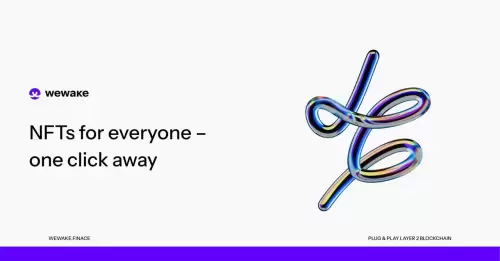 |
|
 |
|
 |
|
 |
|
 |
|
 |
|
 |
|
 |
|
 |
|
 |
|
 |
|
 |
|
 |
|
 |
|
 |
|
지난 달, 나는 다시 한 번 비 크립토 화폐 친구를 시작하려고 노력했다. 튜토리얼에서 10 분 동안 그녀의 눈은“지갑 선택”에 대해 이야기하면서 눈을 돌리기 시작했습니다.“이제 다른 토큰으로 가스 비용을 지불해야합니다.”

Last month, I once again tried to get a non-cryptocurrency friend started. Ten minutes into the tutorial, her eyes started to wander as she was talking about "choosing a wallet" and "now you need to pay for gas in another token."
지난 달, 나는 다시 한 번 비 크립토 화폐 친구를 시작하려고 노력했다. 튜토리얼에서 10 분 동안 그녀의 눈은 "지갑 선택"에 대해 이야기하면서 눈이 방황하기 시작했습니다. "이제 다른 토큰으로 가스 비용을 지불해야합니다."
It suddenly dawned on me: What we’re facing is not a knowledge gap, but a design gap.
갑자기 나에게 새벽이되었습니다. 우리가 직면 한 것은 지식 격차가 아니라 설계 격차입니다.
The harsh reality is that the speculative wave brought in the first wave of users, but it won’t attract the next billion. Real adoption begins when cryptocurrency products become invisible — people can benefit from them without realizing they are using cryptocurrency technology.
가혹한 현실은 투기적인 물결이 첫 번째 사용자의 물결을 가져 왔지만 다음 10 억을 유치하지는 않는다는 것입니다. Cryptocurrency 제품이 보이지 않게 될 때 실제 채택이 시작됩니다. 사람들은 암호 화폐 기술을 사용하고 있다는 사실을 깨닫지 않고 혜택을받을 수 있습니다.
From the rise of stablecoins and institutional staking to the growing role of AI in the development of the digital economy, the foundation for the large-scale application of cryptocurrencies has been laid. But to open up such a future, we must stop requiring users to learn about cryptocurrencies and start building crypto products that allow them to be unaware of the underlying technology.
스테이 블 레코 인의 부상과 제도적 스테이 킹에서 디지털 경제의 발전에서 AI의 역할이 커지는 것에 이르기까지, 암호 화폐의 대규모 적용을위한 기초가 마련되었습니다. 그러나 그러한 미래를 열기 위해서는 사용자가 암호 화폐에 대해 배우고 기본 기술을 알지 못하는 암호화 제품을 구축하도록 요구하지 않아야합니다.
Here are eight narratives and projects worth watching in the cryptocurrency application space.
다음은 cryptocurrency 응용 프로그램 공간에서 시청할 가치가있는 8 가지 이야기와 프로젝트입니다.
Currently, wallets are in a stage of structural transformation: users are forming the habit of using two complementary wallets - one is a wallet for daily use, similar to a fintech app, and the other is a "vault wallet" for asset storage, similar to a bank account.
현재 지갑은 구조적 변환 단계에 있습니다. 사용자는 두 개의 보완 지갑을 사용하는 습관을 형성하고 있습니다. 하나는 핀 테크 앱과 유사한 매일 사용하는 지갑이며, 다른 하나는 은행 계좌와 유사한 자산 저장을위한 "금고 지갑"입니다.
Wallet functionality and experience are diverging. As a result, developers who try to cram all functionality into a single interface will ultimately lose out to developers who focus on (a) frictionless onboarding and (b) high-security storage.
지갑 기능과 경험이 다양합니다. 결과적으로 모든 기능을 단일 인터페이스로 크램하려고하는 개발자는 궁극적으로 (a) 마찰이없는 온 보딩 및 (b) 보안 저장에 중점을 둔 개발자에게 잃게됩니다.
Data shows that most users now use 2-5 wallets, with nearly 48% of respondents saying this is because each blockchain is still isolated in its own "walled garden".
데이터에 따르면 대부분의 사용자는 이제 2-5 지갑을 사용하고 있으며 응답자의 거의 48%가 각 블록 체인이 여전히 자체 "벽으로 둘러싸인 정원"에서 분리되어 있기 때문입니다.
At the same time, there is a top concentration of wallets. Senior users (with more than 2 years of experience) are concentrated on Binance, Coinbase, MetaMask or Trust (accounting for more than 54%), while the share of any single wallet in the novice group is less than 20%.
동시에, 최고 농도의 지갑이 있습니다. 선임 사용자 (2 년 이상의 경험을 가진)는 Binance, Coinbase, Metamask 또는 Trust (54%이상을 차지함)에 집중되며 초보자 그룹의 단일 지갑의 점유율은 20%미만입니다.
In addition, for most users, self-custody is still daunting. An interesting data is that Binance's self-custody solution "Binance Web3 Wallet" has only attracted 22% of users despite providing a familiar brand and a simplified self-custody path, and most users still have concerns.
또한 대부분의 사용자에게는 자기 사용이 여전히 어려워요. 흥미로운 데이터는 Binance의 Selfusty Solution "Binance Web3 Wallet"이 친숙한 브랜드와 단순화 된 자기 사용 경로를 제공 함에도 불구하고 사용자의 22% 만 유치했으며 대부분의 사용자는 여전히 우려 사항이 있다는 것입니다.
In reality, users don’t want to use multiple wallets at the same time. This is not their subjective preference, but they have no choice.
실제로, 사용자는 동시에 여러 지갑을 사용하고 싶지 않습니다. 이것은 주관적인 선호도는 아니지만 선택의 여지가 없습니다.
Obviously, the "seamless multi-chain future" that the industry has been talking about has not really arrived. In addition to 48% of users having multiple wallets mainly to access different blockchain ecosystems, 44% of users actively split their wallets for security reasons, which is a significant increase from 33% last year.
분명히, 업계가 이야기 한 "원활한 멀티 체인 미래"는 실제로 도착하지 않았습니다. 주로 여러 지갑을 가진 사용자의 48%가 주로 다른 블록 체인 생태계에 액세스하기 위해 보안상의 이유로 지갑을 적극적으로 분할하여 작년에 33%에서 상당히 증가했습니다.
It can be seen that the industry has failed to provide true interoperability, thus shifting operational complexity to end users. At the same time, these users are becoming smarter and smarter - they no longer blindly believe that one wallet can handle all scenarios.
업계가 진정한 상호 운용성을 제공하지 못하여 운영 복잡성을 최종 사용자로 이동 시켰음을 알 수 있습니다. 동시에,이 사용자들은 더 똑똑하고 똑똑해지고 있습니다. 더 이상 한 지갑이 모든 시나리오를 처리 할 수 있다고 맹목적으로 믿지 않습니다.
Project Examples
프로젝트 예
Phantom: A popular cryptocurrency wallet that supports Solana and Ethereum.
Phantom : Solana와 Ethereum을 지원하는 인기있는 cryptocurrency 지갑.
The divergence between behavior and belief
행동과 믿음의 발산
Speculation remains the core driver. Although 54% of users actually used cryptocurrencies for payments or peer-to-peer transfers in the past quarter, when asked what their favorite activity was, only 12% of respondents chose payment. Speculation (spot, MeMe coins, DeFi activities) is still the most frequent behavior every week, covering almost all user types. Therefore, speculation will continue to plunder the future attention share of cryptocurrency payments as a utility.
추측은 핵심 드라이버로 남아 있습니다. 사용자의 54%가 실제로 Cryptocurrencies를 결제 또는 피어 투 피어 이체에 사용했지만 지난 분기에 자신이 좋아하는 활동이 무엇인지 물었을 때 응답자의 12%만이 지불을 선택했습니다. 추측 (Spot, Meme Coins, Defi 활동)은 매주 가장 빈번한 행동이며 거의 모든 사용자 유형을 다루고 있습니다. 따라서 추측은 유틸리티로서 cryptocurrency 지불의 미래의주의 점유율을 계속 약탈 할 것입니다.
The core reasons that hinder the development of practical scenarios are three major obstacles:
실제 시나리오의 개발을 방해하는 핵심 이유는 세 가지 주요 장애물입니다.
Project Examples
프로젝트 예
The chain is a new infrastructure layer, but users don’t need to be aware of its existence
체인은 새로운 인프라 계층이지만 사용자는 그 존재를 알고있을 필요가 없습니다.
The essence of a multi-chain ecosystem is a system of division of labor. Chain abstraction will become the winning user experience (UX) model, and wallet sessions can smoothly route orders, balances, and identities to any backend that provides the best combination of latency, cost, and security without requiring users to make a choice.
다중 체인 생태계의 본질은 노동 분업 시스템입니다. 체인 추상화는 UX (Using User Experience) 모델이 될 것이며, 지갑 세션은 사용자가 선택할 필요없이 대기 시간, 비용 및 보안의 최상의 조합을 제공하는 모든 백엔드에 순서, 잔액 및 신원을 원활하게 라우팅 할 수 있습니다.
Currently, Ethereum remains the institutional-grade settlement layer, but Solana is quickly becoming the chain of choice for high-frequency, high-engagement retail activities. From a momentum and growth perspective, Ethereum faces the strongest competitive pressure to date:
현재, 이더 리움은 제도적 등급의 정착 계층으로 남아 있지만, Solana는 고주파 고급 소매 활동을위한 선택의 체인이되고 있습니다. 모멘텀과 성장 관점에서 이더 리움은 현재까지 가장 강력한 경쟁 압력에 직면 해 있습니다.
The survey shows that 43% of respondents said Ethereum is their most commonly used chain; 39% of respondents said it is Solana; only 10% of respondents mainly use L2, which shows that interoperability is still in the theoretical stage rather than the practical stage.
설문 조사에 따르면 응답자의 43%가 Ethereum이 가장 일반적으로 사용되는 체인이라고 응답했습니다. 응답자의 39%가 Solana라고 답했습니다. 응답자의 10%만이 주로 L2를 사용하는데, 이는 상호 운용성이 여전히 실제 단계가 아닌 이론적 단계에 있음을 보여줍니다.
Project Examples
프로젝트 예
The illusion of increased security
보안 증가의 환상
Users claim to feel more secure on-chain, but their wallets tell a different story.
사용자는 체인이 더 안전하다고 느끼고 있다고 주장하지만 지갑은 다른 이야기를합니다.
So, how do we explain this paradox?
그렇다면이 역설을 어떻게 설명합니까?
In fact, users confuse personal enhancements (
실제로 사용자는 개인 향상을 혼동합니다 (
부인 성명:info@kdj.com
제공된 정보는 거래 조언이 아닙니다. kdj.com은 이 기사에 제공된 정보를 기반으로 이루어진 투자에 대해 어떠한 책임도 지지 않습니다. 암호화폐는 변동성이 매우 높으므로 철저한 조사 후 신중하게 투자하는 것이 좋습니다!
본 웹사이트에 사용된 내용이 귀하의 저작권을 침해한다고 판단되는 경우, 즉시 당사(info@kdj.com)로 연락주시면 즉시 삭제하도록 하겠습니다.






























































